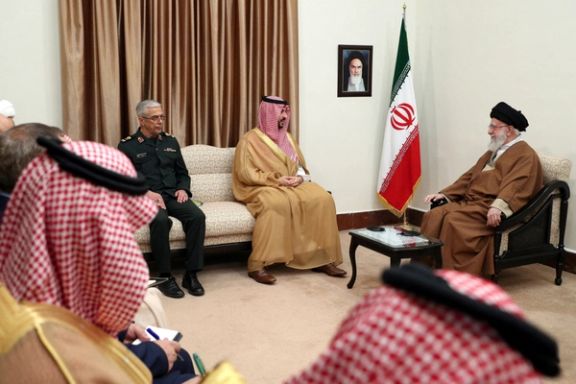Related Articles
Saudi Arabia's stance on negotiations with Iran over its nuclear program has shifted significantly in the past decade, moving from opposition to support as regional dynamics and the kingdom's priorities evolve, according to an analysis by the New York Times.
The writer pointed out that ten years ago, Saudi officials criticized the deal struck by former US President Barack Obama as weak and empowering Iran. However, it added, as a second Trump administration engages in talks with Iran on a potentially similar agreement, Saudi Arabia has expressed hope for a positive outcome, emphasizing the importance of regional stability.
The Riyadh-based writer, Vivian Nereim, attributed this change to several factors, including improved Saudi-Iranian relations and Saudi Arabia's ambitious economic diversification plans, which are threatened by regional tensions and potential conflict.
After years of severed ties, including a complete break in 2016, Iran and Saudi Arabia announced a formal reconciliation in 2023, with China mediating the detente.
The analysis concludes that Iran's increased regional outreach and the shared interest in avoiding escalation have contributed to the Persian Gulf states' support for the ongoing negotiations.
Earlier in the day, Alireza Enayati, Tehran's ambassador to Riyadh, said Saudi Arabia has a positive view of Iran's negotiations.

Oman has long served as a discreet and trusted intermediary between Tehran and Washington. Its role dates back to the early 2010s, when Muscat hosted secret backchannel talks that ultimately led to the 2015 nuclear deal (JCPOA).
The United States also sees Oman as a discreet and stable mediator with a history of hosting secret talks with Tehran.
Continue reading the analysis here.

Iran’s deployment of advanced enrichment machines adds complexity to ongoing nuclear talks.
Read how this escalation is altering negotiation dynamics and testing the resolve of international stakeholders here.


Diplomatic sources told Iran International this week that President Donald Trump’s envoy, Steve Witkoff, “welcomed a three-stage proposal presented by the Iranian side” during the first round of negotiations in Oman on April 12.
The report published on Thursday said that Iran offered to temporarily reduce the level of its uranium enrichment in exchange for significant sanctions relief, including permission to export oil, as the first phase of an agreement with the United States. Later phases would involve Tehran making a “permanent” pledge not to enrich uranium beyond the 3.67% limit set by the Obama-era JCPOA. The arrangement would also include Iran shipping out highly enriched uranium to a third country in exchange for further sanctions relief, including the lifting of longstanding US sanctions.
The sources told Iran International that Witkoff’s positive response to the Iranian proposal surprised their delegation in Muscat.
What the diplomats did not clarify is the fate of roughly 17,000 uranium enrichment machines, known as centrifuges—arguably the most critical component of Iran’s current nuclear program. These are the machines capable of refining uranium to weapons-grade levels of 90%.
Under the JCPOA agreement, Iran was allowed to keep 5,000 machines in operation for ten years, with roughly 7,500 centrifuges kept in storage. That limitation that Tehran has already violated would end in 2025.
Since the US withdrew from the JCPOA, Iran has significantly increased its number of centrifuges in operation and deployed more advanced models with higher output. If Tehran is allowed to retain a substantial portion of this infrastructure, it could resume higher-level enrichment at any time.
The Arms Control Association said in 2022 that, “Several of Iran’s escalatory breaches have resulted in its acquisition of new knowledge and expertise that cannot be reversed.”
The Islamic Republic urgently needs sanctions relief, as its economy is in deep crisis and the national currency has lost nearly half its value since September. If the United States lifts some sanctions and unfreezes assets in exchange for only a temporary reduction in enrichment, Tehran will feel less pressure to move quickly toward further phases of the proposed agreement.
This could allow Iran to stall for time—as it did during the Biden administration—until President Trump nears the end of his term and the 2028 election campaign begins. This may explain why Tehran, according to the report, has prioritized the lifting of oil export sanctions in the first phase.
Iran has consistently insisted that the US must “show good faith” in any negotiation. This has typically meant lifting at least some of the sanctions reimposed by President Trump in 2018. Tehran has also called for an end to US “pressure,” a demand that could reduce Washington’s leverage in protracted talks if sanctions are eased too early.
Iran began enriching uranium to 60 percent in 2021 following a December 2020 parliament decision to retaliate against the US. Interestingly, for more than two years Iran waited during the first Trump term before taking any drastic retaliatory step and only upped the ante after President Joe Biden’s election. Until then, enrichment levels had remained below 5 percent.
If Iran retains its centrifuge infrastructure, it remains capable of resuming high-level enrichment—as it has done since 2021. One of the core criticisms of the JCPOA is that it never fully banned enrichment, and many of its key restrictions are now approaching expiration.
On the diplomatic and economic fronts, a partial or phased agreement would allow Iran to build closer ties with countries such as India, and trade more freely with China and Europe. That would reduce the urgency currently driving Iran’s negotiations—and could complicate US efforts to pursue a phased deal in a meaningful way.
Iranian media offer conflicting accounts of the country’s talks with the US, reflecting a fractured narrative and growing confusion.
Read the analysis here.

